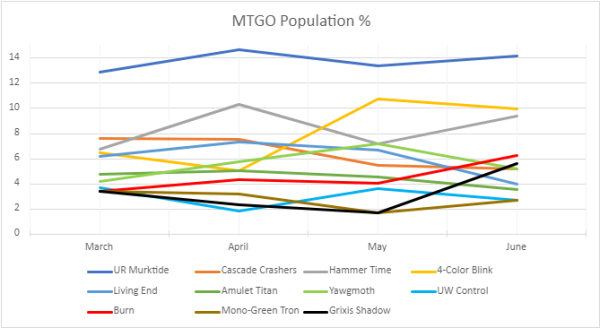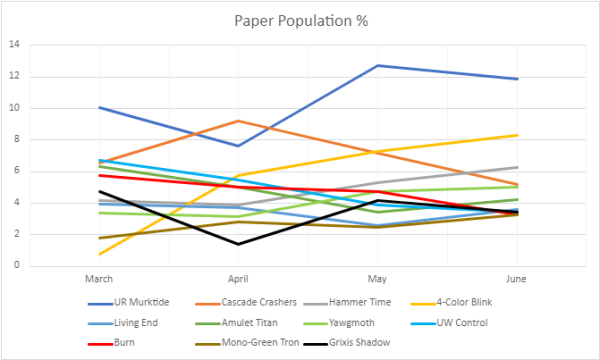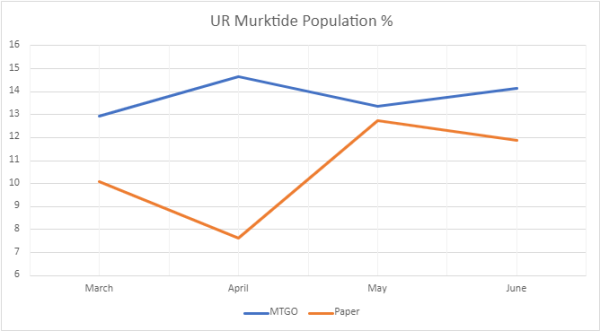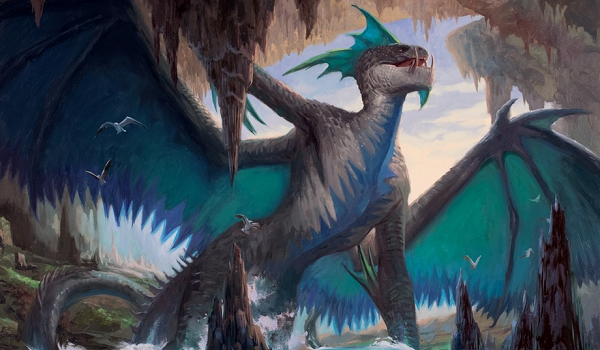Are you a Quiet Speculation member?
If not, now is a perfect time to join up! Our powerful tools, breaking-news analysis, and exclusive Discord channel will make sure you stay up to date and ahead of the curve.
It's the Friday after the metagame update, and so time to dig in and actually explain the data. After all, data is just data. It doesn't mean anything until interpreted, and how it is ultimately interpreted determines its meaning. Thank you for attending my TEDtalk on data analysis, make you stop by the gift shop on your way home.
On a related note, I finally have enough data to start making charts to visually back up the trends I'm discussing. I'm basically winging things and figuring out how this will all work as I go, so if anyone has suggestions, please feel free to leave comments on what you want to see.
The Big Dragon in the Room
For yet another month, UR Murktide was not only the #1 deck in Modern, but it was also a statistical outlier. Which I'm not going to get into as I've beaten that horse to death already. Shame it doesn't work on Dragons. Anyway, what is significant is the effect that this is having on Modern as a whole. Wizards has stated that Murktide's win percentage isn't threatening enough to warrant a ban despite its high metagame share. Which meshes with what I see in the data available to me. However, Murktide's outlier status is affecting the rest of the format.
The Trend That Isn't
It is neither accurate nor fair to directly compare the raw data month to month. There are a million things that affect both population numbers and point allocations such that both fluctuate wildly and without apparent cause. You can only really consider population changes in the long run and even then, only if the underlying conditions have remained comparable. When those conditions are met, you can absolutely judge a Magic format based on attendance for whether there's an impact.
I can't actually do that currently, which I need to make clear from the get-go. The monthly population numbers in both paper and online have too many variables impacting them to be a reliable measure of Modern's health. Even if that wasn't true, there'd be nothing there anyway. Modern's population has been up and down so much this year that there aren't reliable conclusions to be reached. Instead, we have to dig deeper.
A Metagame Constrained
I believe that while Modern's top decks aren't inherently problematic by the normal metrics, they are constraining what is viable simply by squeezing out other decks. Not in the fairly healthy "no-longer-viable, the metagame has moved on, etc." way. Rather, there's physically less room available for other decks to compete in Modern, especially online.
Consider if you will the top 11 decks from March. I know that feels weird, but Burn, Tron, and Grixis Shadow all had the same population on MTGO. Cutting one to make a more typical 10 would have been unacceptably arbitrary. Then track their metagame share until the last metagame update and see how they collectively perform.
| Deck Name | March % | April % | May % | June % |
|---|---|---|---|---|
| UR Murktide | 12.92 | 14.65 | 13.37 | 14.14 |
| Cascade Crashers | 7.58 | 7.55 | 5.49 | 5.20 |
| Hammer Time | 6.74 | 10.3 | 7.16 | 9.36 |
| 4-Color Blink | 6.46 | 5.03 | 10.74 | 9.98 |
| Living End | 6.18 | 7.32 | 6.68 | 3.95 |
| Amulet Titan | 4.78 | 5.03 | 4.53 | 3.53 |
| Yawgmoth | 4.21 | 5.72 | 7.16 | 5.20 |
| UW Control | 3.65 | 1.83 | 3.58 | 2.70 |
| Burn | 3.37 | 4.35 | 4.06 | 6.24 |
| Mono-Green Tron | 3.37 | 3.20 | 1.68 | 2.70 |
| Grixis Shadow | 3.37 | 2.29 | 1.68 | 5.61 |
I realize that it's difficult to pick anything out from that table of apparently random data. That's what graphs are for. And look, here's one now:

This chart is a bit chaotic thanks to all the different decks on it, but looking carefully shows that decks are constantly rising and falling over the course of the quarter year on MTGO. Dynamism and competitive diversity being one of the hallmarks of metagame health, it looks like everything is fine in Modern except for Murktide being far above everything else. This is further backed up when paper is considered:
| Deck Name | March % | April % | May % | June % |
|---|---|---|---|---|
| UR Murktide | 10.08 | 7.64 | 12.75 | 11.88 |
| Cascade Crashers | 6.52 | 9.20 | 7.16 | 5.20 |
| Hammer Time | 4.15 | 3.90 | 5.30 | 6.25 |
| 4-Color Blink | 0.79 | 5.77 | 7.31 | 8.28 |
| Living End | 3.95 | 3.74 | 2.58 | 3.59 |
| Amulet Titan | 6.32 | 4.99 | 3.44 | 4.22 |
| Yawgmoth | 3.36 | 3.12 | 4.73 | 5.00 |
| UW Control | 6.72 | 5.46 | 3.87 | 3.43 |
| Burn | 5.73 | 4.99 | 4.73 | 3.28 |
| Mono-Green Tron | 1.78 | 2.81 | 2.44 | 3.28 |
| Grixis Shadow | 4.74 | 1.40 | 4.15 | 3.43 |
Those are a lot of very different numbers from before, but it isn't apparent how different paper is to MTGO until you see it graphically:

I'd actually forgotten that Murktide not only wasn't an outlier in April, but that it wasn't even the #1 deck in paper. It got revenge for that slight in May, clearly, but it does show that there's still a lot of movement and change even if there are a few consistent overperformers. Observant readers will cross-check this data with the metagame update and see that many of these decks have changed tiers repeatedly from the starting point in March.
The Catch
And all of that is completely true. However, that's not the whole story here. There is something problematic about these 11 decks that started out the study period as the top 11 decks on MTGO but no longer are. However, that will take another table to spell out:
| April % | May % | June % | July % | |
|---|---|---|---|---|
| MTGO | 62.63 | 67.27 | 66.13 | 68.61 |
| Paper | 54.14 | 53.02 | 54.31 | 57.84 |
Yes, that's correct: over 2/3 of MTGO is just 11 decks. Which aren't even still the top 11 deck on MTGO. Paper is not quite so bad, but looking at the trend line, I'm not holding out much hope. And that's not even considering what I'm seeing as the July is coming in.

Which brings me to the earlier point: when the top decks are physically taking up most of the metagame, how can anything else make it in? In a more dynamic metagame, decks rising and falling unevenly leaves plenty of percentage laying around for new decks to take. A more static one becomes exclusionary.
A Frustrating Problem
If this trend toward consolidation is in fact as worrying as I posit, then it is also a very frustrating one. There is no one thing that is propelling this metagame that I can point to as the cause and therefore no single solution that I can propose. I know that many will simply blame Modern Horizons 2's power level as the perpetrator. UR Murktide can plausibly be seen as Modern Horizons 2 tribal, after all.
However, this is not merely reductive but incorrect. Yes, the Horizons sets have a sufficiently high power level as to define Modern, which is probably what Wizards intended. And yes, it is high enough that it's unlikely that anything from Standard-legal sets will disturb this equilibrium without proving insanely broken.
However, consider again that the Horizons tribal deck doesn't have a great win/loss record! Or note that neither Burn nor Tron have benefitted from any Horizons cards yet remain metagame threats. Or that Cascade Crashers, another Horizons tribal deck (I'd say moreso than Murktide), is highly volatile and falls in and out of Tier 1 seemingly at random. The power of Modern Horizons is certainly impacting Modern, but it isn't the only factor at play.
The Key
To bang that drum again, this is a metagame being defined by players playing what they want to play! The top decks in my updates are very popular and place consistently, but they don't win tournaments more than other decks. I don't think Murktide's actually won anything large in over a month. Its place in the metagame is not justified by performance or power, but popularity.
Murktide is the poster child for this phenomenon, but the same applies to Omnath, Locus of Creation decks. They don't actually win that often, and rarely show up at all in smaller events. However, players that play in larger tournaments choose the 4-Color piles of every description in very high numbers because they think it will give them an edge. Maybe it does on an individual level, but in aggregate they're not doing any better than anyone else.
The fact that players are playing decks like this and others are playing decks to counter them (Burn has a very good Blink matchup, for example) is what is actually driving the metagame. And with players now choosing to play their respective favorite decks, I doubt that there will be much movement in coming months. Unless Wizards decides that Murktide's metagame share needs adjusting.
The Divergence
One other thing to note is how different the paper and MTGO actually are. The end result isn't that different, it's true, but the details do show how different the two really are. I noticed this looking at the Murktide shares:

This is typical of all the decks I've been looking at. They rise and fall on paper and MTGO with no rhyme or rhythm in relation to each other. Such that I can't possibly prognosticate the specifics of where Modern will be when I write the next of these analysis articles. Though it is a safe assumption that Murktide will still be an outlier followed by some combination of 4-Color Blink and Hammer Time. That's how it's been so far, and I don't think that anything in the metagame will change that.
Is There Opportunity Here?
As always, we'll end with where the Modern card market is headed. And... well, you have already picked up and/or moved all the MH2 cards you were going to, right? The evidence of the Traders Tools shows that most Modern staples prices have stabilized and, in many cases, have fallen from the same time last year. The simple fact is that there is downward pressure in Modern thanks to the aforementioned deck stability. Many players now have the deck they intend to play for the foreseeable future, plus or minus some flex slots, and won't be purchasing many cards.
Newer and non-MH2 cards are exceptions thanks to pressure from Standard and Pioneer so there may be opportunity there. However, if your intent was to profit from Modern exclusives, I have bad news. And it won't be getting better in the short term. The reprints from Double Masters 2 are increasing general supply enough for there to increase the downward price pressure (outside of collectors) and with Pioneer being the competitive focus for the moment, don't expect demand to push prices up.
Long-term that could certainly change if Modern is the next qualifier season or there are many other large events. Those developments might present an opportunity to buy up inventory and wait for prices to rise. But I must caution that you never know what Wizards will do. They banned a card in a format that wasn't supposed to have bannings this week, so it's quite possible for them to turn around and ban something from Modern too. There's no way to know, nor any way to know how it will impact prices.
Stability Feels Weird
After so long of Modern constantly churning, it feels wrong for Modern to be predictable and stable. Whether it's actually good for players or not, I have no clue. It's been so long that I don't know what to think. Hopefully by this time next month I'll have a better idea.





